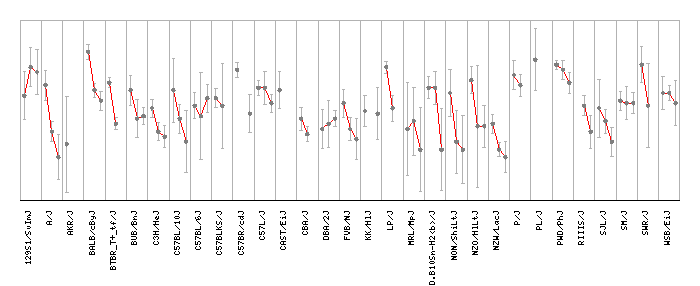 Search
Search
Ploticus >
Scripts >
 proc catlines displays individual plots, one per category in X.
Useful in comparing various entities, each of which have a displayable characteristics curve.
Typically line plots are rendered, but column bars are also possible. Error bars and
data point symbols are optional. New in 2.40
proc catlines displays individual plots, one per category in X.
Useful in comparing various entities, each of which have a displayable characteristics curve.
Typically line plots are rendered, but column bars are also possible. Error bars and
data point symbols are optional. New in 2.40
Plot data set must be ordered on category then subcategory.
Categories must be set up in X (based on catfield, see below), and a numeric
axis in Y.
Attributes
catfield, subcatfield, valfield, and subcats attributes must all be specified.
plotmode
lines | bars | symonly
Controls the type of plot rendered for each category.
Default is lines which gives lineplots. If bars is specified bar graphs will be rendered instead
(and see the column bar options below).
If symonly is specified no line plot or bar graph will be generated, and you must specify dpsymbol (see below) to
plot data points only. bars and symonly are new in 2.41
catfield
dfield
A data field that contains primary category tags.
This is the same data field that plot area X axis categories should be based on.
There will be one curve drawn for each primary category.
subcatfield
dfield
A data field that contains secondary category tags.
Secondary categories determine plot position within a given curve.
Specify the set of allowable secondary categories in the subcats attribute.
valfield
dfield
A data field that contains the numeric plottable value.
subcats
list | auto
A comma-delmited or space-delimited list of allowable subcats, or else auto which causes
the data set to be scanned to determine the list of allowable subcats at some performance penalty.
The order found here determines the left-to-right plotting position.
Example: subcats: A B C
Example: subcats: auto
errfield
dfield
A data field that contains a numeric error bar value. Optional.. if omitted no error bars will be drawn.
For example if valfield contains means, this field might contain SEM or SD.
plotwidth
h
Controls the width of the plot region within the category space and allows for separating margins on each side.
Usable range of h is 0.2 to 0.8 or so.
For lineplots default is 0.6 ; for bars the default is set based on number of subcategories.
select
select expression
Allows data rows to be selected for inclusion using a selection expression.
Example: @@2 = B
Lineplot options
linedetails
linedetails
Color, line width, dash style for lineplot curves.
gapmissing
yes | no
Default is yes.
If no, data points that are missing in any curve will be bridged.
If yes, missing data points cause the curve to be interrupted.
Column bar options
You must specify plotmode: bars in order to use these options. New in 2.41
barcolor
color
Specify this attribute if you want all bars in a group to be this color.
Default is green.
barcolorlist
list of
color
Specify this attribute if you want bars in a group to have different colors.
A comma- or space-delimited list of
colors.
Example: barcolorlist: green,red,blue
barlinewidth
linewidth
Linewidth of bars. Default is 2.0 ; use higher numbers for thicker bars, lower numbers for thinner bars.
crossover
h
If specified, values less than h will result in downward bars.
Typically specified as 0 so that negative values give downward bars.
Data point options
Data point symbols can be rendered with lineplots (plotmode: lines) or alone (plotmode: symonly).
dpsymbol
symboldetails
Default is for small light-gray data point symbols to be rendered
(specifically, style=filled color=gray(0.7) shape=circle radius=0.02).
Specify another
symboldetails
for a different data point symbol.
Specify none to omit data points.
altsymbol
symboldetails
If specified, defines an alternate symbol to be drawn when altwhen condition is true.
altwhen
select expression
A conditional expression that, if true, causes the altsymbol to be drawn instead of the
dpsymbol.
Error bar options
Error bars will be rendered if errfield is specified (see above).
errbardetails
linedetails
Color and line width for error bars.
taillen
h
Size of error bar tails in inches (cm). Default is 0.04 inches.
|









